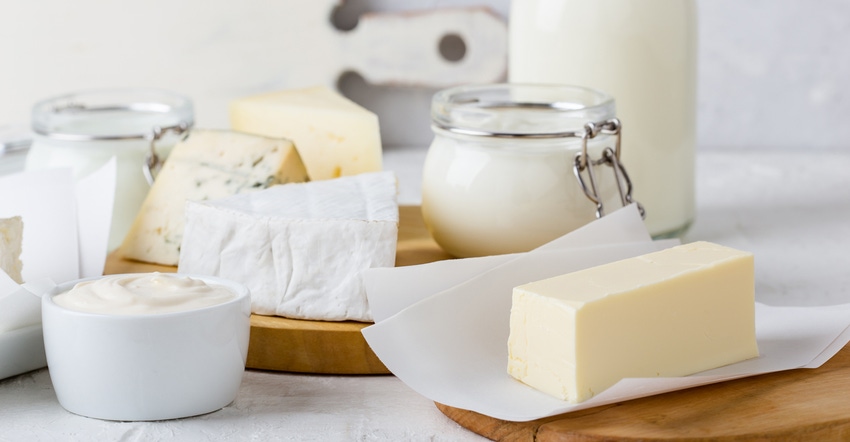
Good news for improved milk prices is milk production continues to slow, says Bob Cropp, University of Wisconsin-Madison dairy economist.
“For the last quarter of 2018, milk production was just 0.5% above a year earlier. January’s production was up 0.9%, and February was up just 0.2%,” Cropp explains. “The number of milk cows started to decline last June, and while there was no change from January to February, cow numbers had declined 63,000 head and were now 77,000 head, or 0.8%, lower than a year ago. The increase in milk per cow continues below trend, being up 1% in 2018 and 1.1% in February.”
Fluid beverage milk sales declined another 2% last year, with modest growth in butter and cheese sales. According to Cropp, this type of pattern is expected to continue through 2019.
Record exports
Dairy exports were a record high in 2018, totaling 15.8% of milk production, compared to 14.5% in 2017. Compared to 2017, exports of cheese were 2% higher; butterfat, 61% higher; and nonfat dry milk/skim milk powder, 18% higher. There was no change in total whey products.
“Exports were robust for the first half of the year and dampened the second half of the year after China, Mexico and Canada imposed retaliatory tariffs on U.S. dairy products,” Cropp notes. “On a milkfat milk equivalent basis, exports in the first half of 2018 grew by 18.9% over that of 2017 but declined to 8% for the second half of the year. On a skim-solids milk equivalent basis, exports in the first half of the year grew by 19.8% over 2017, but in the third quarter, the growth declined to 12.8%, and in the fourth quarter, exports were below 2017 by 12.2%.”
By December 2018, exports on a total milk solids basis had declined to 12.8% of milk production. Looking ahead, there are some positive factors for exports. Milk production is expected to show only a modest increase in the European Union and a reduction in Australia, and a possible drought in New Zealand could dampen their milk production, Cropp says. “World dairy product prices are increasing. But as long as retaliatory tariffs exist, exports will be hindered. USDA forecasts 2019 exports on a milkfat basis to be down 3.8% and on a skim-solids basis up just 1%.”
Cheese stocks remain at rather higher levels, holding down cheese prices. Jan. 31 cheese stocks grew a little from December, with American cheese stocks 8.6% higher than a year ago and total cheese stocks 6.4% higher. Butter stocks normally increase going into summer, as cream supplies are more available than when ice cream production picks up for summer sales. Jan. 31 butter stocks were 6.9% lower than a year ago.
Despite a slower growth in milk production, ample cheese stocks, modest growth in domestic demand and reduced growth in dairy exports have kept milk prices from showing much improvement.
“The Class III price was $13.89 in January and $13.96 in February. Earlier in the month, barrel cheese was just $1.36 per pound, and 40-pound blocks were $1.52 per pound. Prices have improved to $1.51 for barrels and $1.58 for blocks. But dry whey prices continue to weaken, from 36 cents per pound early in the month to now 30 cents.
“To get $16 Class III prices, cheese needs to get above $1.70 per pound,” Cropp says. “It looks like March Class III will increase to about $14.95. Dairy futures continue to show very slow price recovery, with Class III reaching the low $15s in April and not reaching the $16s until August, and only topping out in the low $16s in October. But I look for the Class III price to do better than this. After four years of low milk prices and starting 2019 with low milk prices, the growth in milk production is likely to stay below 1% for a while.”
The number of licensed dairy herds in 2018 declined 2,731, or 6.8%. Herd numbers continue to fall, according to USDA. Cow numbers will likely continue to decline through at least the first half of the year.
Slaughter cow numbers high
�“Slaughter cow numbers continue to run above a year ago, and the number of dairy replacements expected to enter the dairy herd during the year are down 1% from a year ago,” Cropp says. “With some forage quality issues until a new crop and lower returns over feed cost, the increase in milk per cow is likely to be dampened. So, I see the possibility of much stronger Class III prices for the last six months, and reaching the mid- to high $16s by fourth quarter.”
Butter prices have held around $2.28 per pound and should stay there and strengthen some by the fourth quarter, Cropp predicts. Nonfat dry milk prices should hold close to 95 cents per pound and higher for most of the year.
In 2018, the average all-milk price was $16.18, compared to $17.65 in 2017. It was the lowest average since $12.85 in 2009. “While milk prices will improve in 2019 over that of 2018, they will keep operating margins for dairy farmers rather tight until at least the last quarter of the year,” Cropp says.
About the Author(s)
You May Also Like






